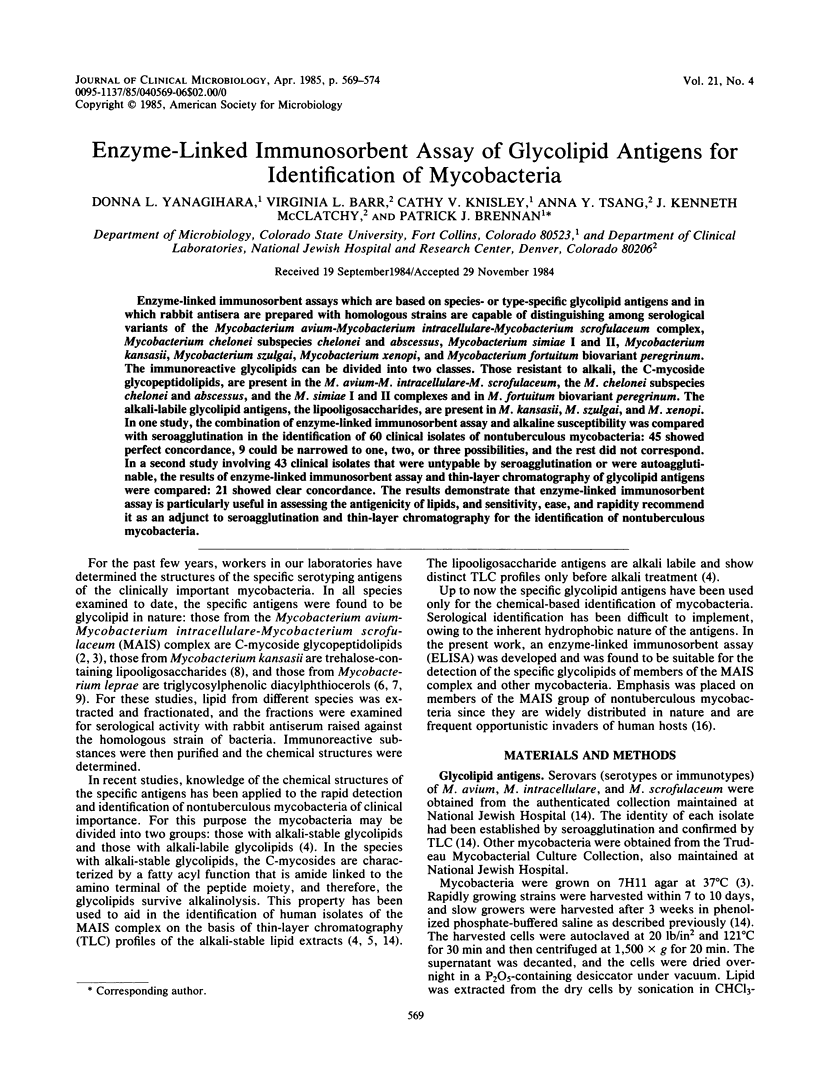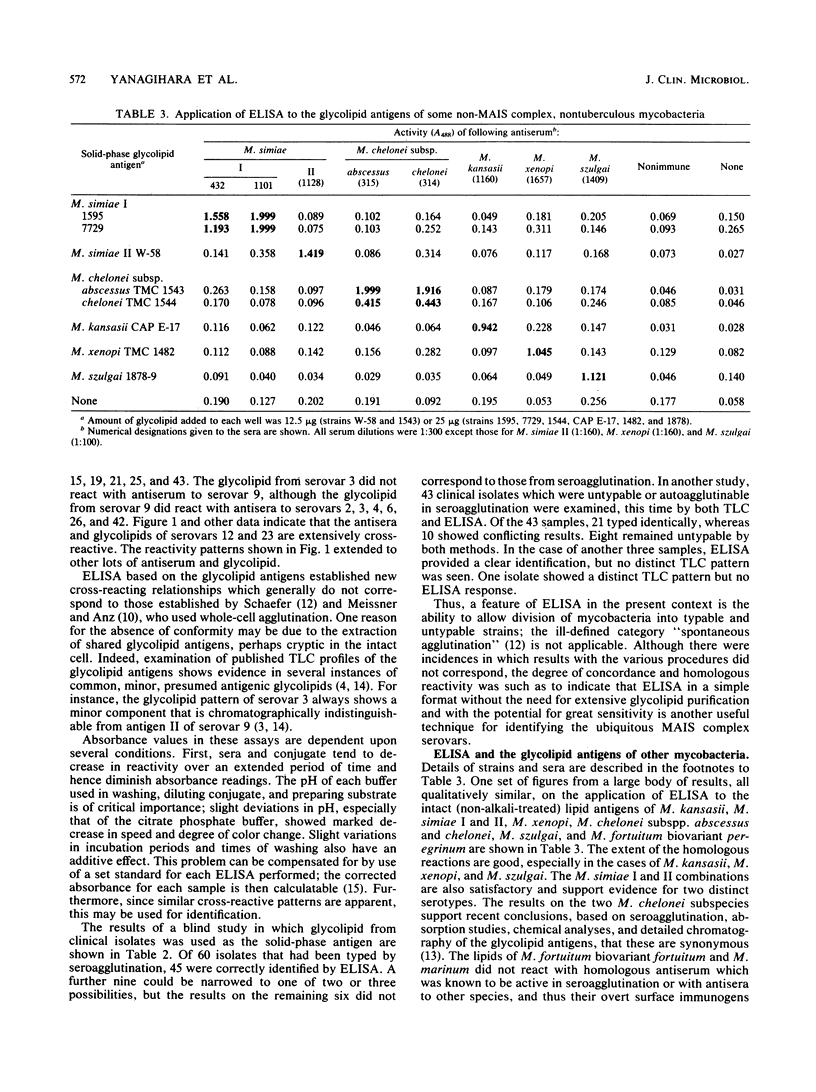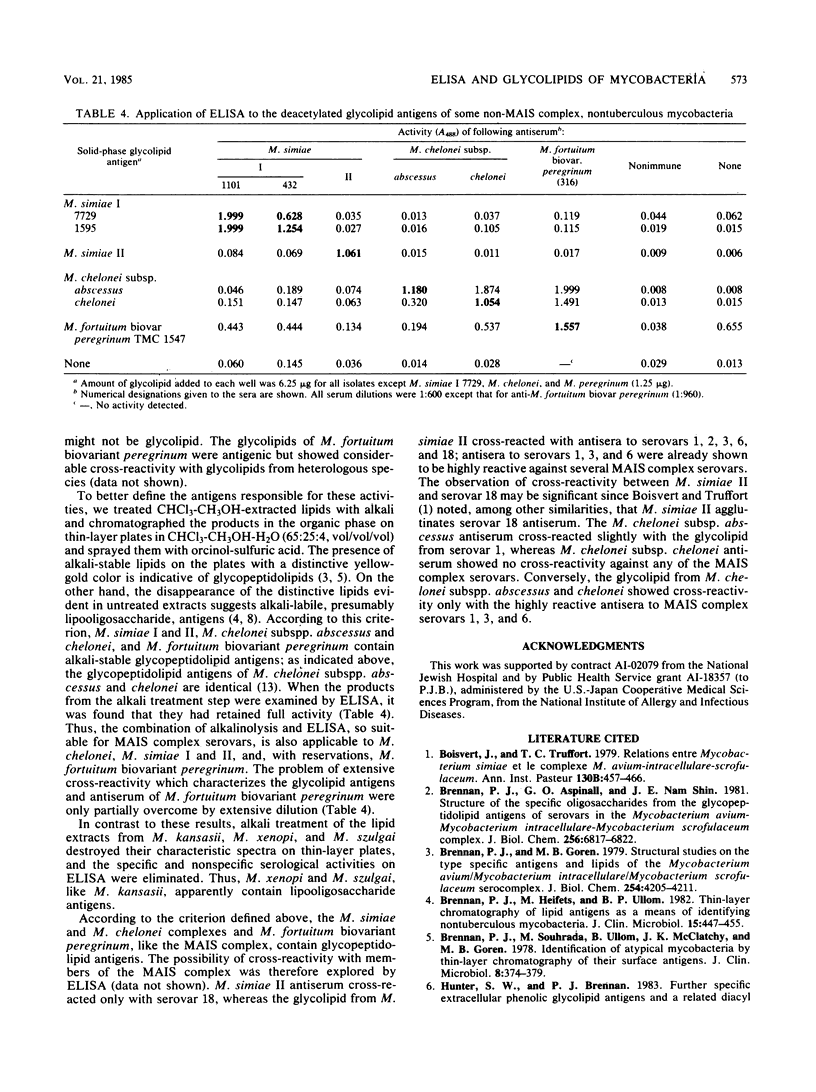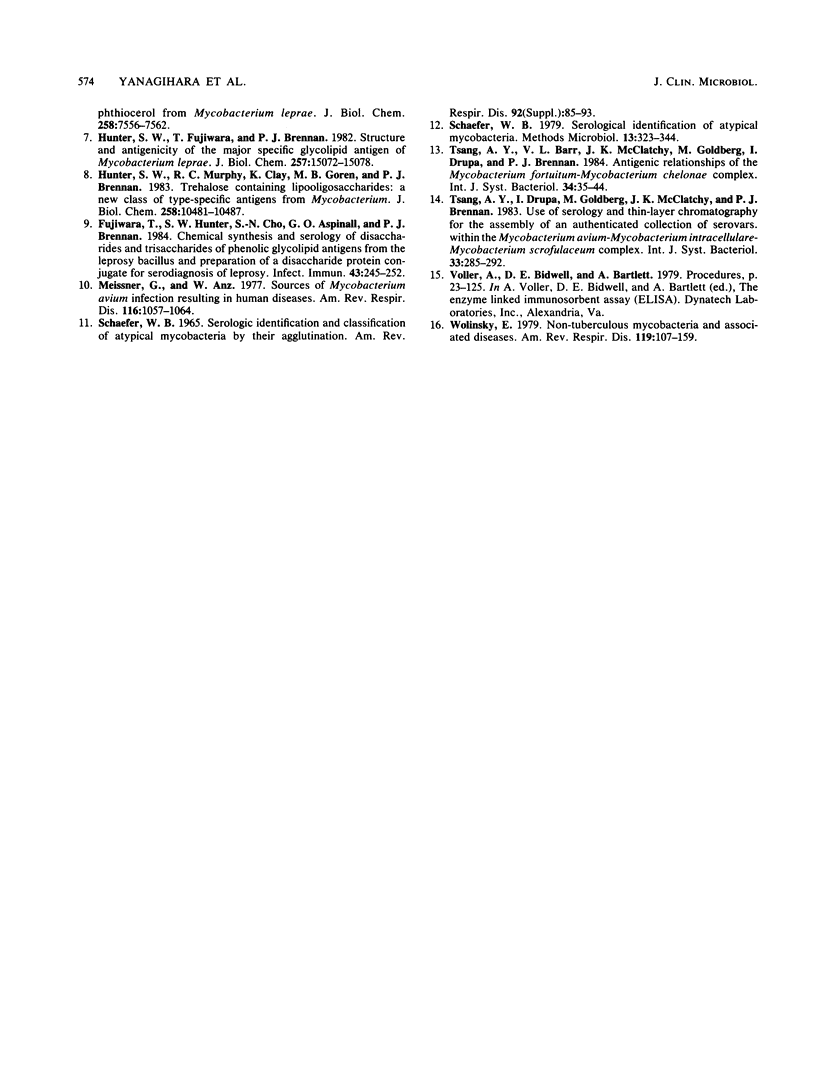Abstract
Enzyme-linked immunosorbent assays which are based on species- or type-specific glycolipids antigens and in which rabbit antisera are prepared with homologous strains are capable of distinguishing among serological variants of the Mycobacterium avium-Mycobacterium intracellulare-Mycobacterium scrofulaceum complex, Mycobacterium chelonei subspecies chelonei and abscessus, Mycobacterium simiae I and II, Mycobacterium kansasii, Mycobacterium szulgai, Mycobacterium xenopi, and Mycobacterium fortuitum biovariant peregrinum. The immunoreactive glycolipids can be divided into two classes. Those resistant to alkali, the C-mycoside glycopeptidolipids, are present in the M. avium-M. intracellulare-M. scrofulaceum, the M. chelonei subspecies chelonei and abscessus, and the M. simiae I and II complexes and in M. fortuitum biovariant peregrinum. The alkali-labile glycolipid antigens, the lipooligosaccharides, are present in M. kansasii, M. szulgai, and M. xenopi. In one study, the combination of enzyme-linked immunosorbent assay and alkaline susceptibility was compared with seroagglutination in the identification of 60 clinical isolates of nontuberculous mycobacteria: 45 showed perfect concordance, 9 could be narrowed to one, two, or three possibilities, and the rest did not correspond. In a second study involving 43 clinical isolates that were untypable by seroagglutination or were autoagglutinable, the results of enzyme-linked immunosorbent assay and thin-layer chromatography of glycolipid antigens were compared: 21 showed clear concordance. The results demonstrate that enzyme-linked immunosorbent assay is particularly useful in assessing the antigenicity of lipids, and sensitivity, ease, and rapidity recommend it as an adjunct to seroagglutination and thin-layer chromatography for the identification of nontuberculous mycobacteria.
Full text
PDF





Images in this article
Selected References
These references are in PubMed. This may not be the complete list of references from this article.
- Boisvert H., Truffot C. Relations entre Mycobacterium simiae et le complexe M. avium-intracellulare-scofulaceum. Ann Microbiol (Paris) 1979 Nov-Dec;130B(4):457–466. [PubMed] [Google Scholar]
- Brennan P. J., Aspinall G. O., Shin J. E. Structure of the specific oligosaccharides from the glycopeptidolipid antigens of serovars in the Mycobacterium avium-Mycobacterium intracellulare-Mycobacterium scrofulaceum complex. J Biol Chem. 1981 Jul 10;256(13):6817–6822. [PubMed] [Google Scholar]
- Brennan P. J., Goren M. B. Structural studies on the type-specific antigens and lipids of the mycobacterium avium. Mycobacterium intracellulare. Mycobacterium scrofulaceum serocomplex. Mycobacterium intracellulare serotype 9. J Biol Chem. 1979 May 25;254(10):4205–4211. [PubMed] [Google Scholar]
- Brennan P. J., Heifets M., Ullom B. P. Thin-layer chromatography of lipid antigens as a means of identifying nontuberculous mycobacteria. J Clin Microbiol. 1982 Mar;15(3):447–455. doi: 10.1128/jcm.15.3.447-455.1982. [DOI] [PMC free article] [PubMed] [Google Scholar]
- Brennan P. J., Souhrada M., Ullom B., McClatchy J. K., Goren M. B. Identification of atypical mycobacteria by thin-layer chromatography of their surface antigens. J Clin Microbiol. 1978 Oct;8(4):374–379. doi: 10.1128/jcm.8.4.374-379.1978. [DOI] [PMC free article] [PubMed] [Google Scholar]
- Fujiwara T., Hunter S. W., Cho S. N., Aspinall G. O., Brennan P. J. Chemical synthesis and serology of disaccharides and trisaccharides of phenolic glycolipid antigens from the leprosy bacillus and preparation of a disaccharide protein conjugate for serodiagnosis of leprosy. Infect Immun. 1984 Jan;43(1):245–252. doi: 10.1128/iai.43.1.245-252.1984. [DOI] [PMC free article] [PubMed] [Google Scholar]
- Hunter S. W., Fujiwara T., Brennan P. J. Structure and antigenicity of the major specific glycolipid antigen of Mycobacterium leprae. J Biol Chem. 1982 Dec 25;257(24):15072–15078. [PubMed] [Google Scholar]
- Hunter S. W., Murphy R. C., Clay K., Goren M. B., Brennan P. J. Trehalose-containing lipooligosaccharides. A new class of species-specific antigens from Mycobacterium. J Biol Chem. 1983 Sep 10;258(17):10481–10487. [PubMed] [Google Scholar]
- Meissner G., Anz W. Sources of Mycobacterium avium complex infection resulting in human diseases. Am Rev Respir Dis. 1977 Dec;116(6):1057–1064. doi: 10.1164/arrd.1977.116.6.1057. [DOI] [PubMed] [Google Scholar]
- Schaefer W. B. Serologic identification and classification of the atypical mycobacteria by their agglutination. Am Rev Respir Dis. 1965 Dec;92(6):85–93. doi: 10.1164/arrd.1965.92.6P2.85. [DOI] [PubMed] [Google Scholar]
- Wolinsky E. Nontuberculous mycobacteria and associated diseases. Am Rev Respir Dis. 1979 Jan;119(1):107–159. doi: 10.1164/arrd.1979.119.1.107. [DOI] [PubMed] [Google Scholar]



